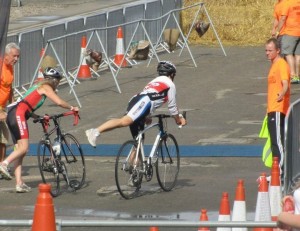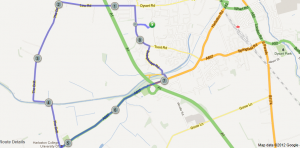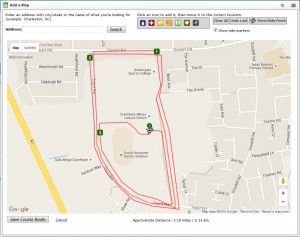Tips for your first triathlon!
 Triathlon is still one of the fastest growing sports in the UK and one of the most exciting. It is an endurance race covering 3 disciplines: swimming, cycling and running continuously over various distances. It can also be a little daunting for the first timer so hopefully some of the following advice will help you get prepared and most importantly enjoy your first race.
Triathlon is still one of the fastest growing sports in the UK and one of the most exciting. It is an endurance race covering 3 disciplines: swimming, cycling and running continuously over various distances. It can also be a little daunting for the first timer so hopefully some of the following advice will help you get prepared and most importantly enjoy your first race.
Triathlon is great fun and you don’t have to be ‘super fit athlete’ to take part, in fact you don’t even have to good at any of the 3 sports.
Although many triathlons include open water swimming in rivers, lakes or sea, most beginner events are based in the swimming pool.
The information below is only a guide and you must always consult your GP before beginning any new fitness or training regime.
If you’re not sure what Triathlon involves we have broken it down for you:
Stage 1 – Swimming
The Triathlon race starts with swimming – beginner races are always in a pool, later some people will progress to ‘open water’ swimming which is an experience in itself! Most triathletes use a front crawl for speed, however you will see people in races doing breaststroke which is absolutely fine.
Transition from the swim to bike – also called T1
Get out of the pool and head for your bike as quickly and safely as you can (you will have a designated spot/area where your bike is) Put you trainers, t-shirt, shorts & helmet on over your swim wear and head out of transition. You must have your helmet on before you can touch your bike (safety is always the first concern of the race referees). You may find it useful to have a towel by you bike to dry your feet and to help mark your spot, you will be able to set up your transition area before you start the race, the marshals and race organisers will direct you accordingly. Please note that nudity is not permitted in transition!!
Stage 2 – Bike
No helmet = no racing. Don’t worry if you only have a mountain bike, lots of people will use them when they are starting out. In a race situation there will be marshals and signs around the course to show you which way to go. You must obey the highway code and respect other road users.
Transition from the bike to run – also called T2
Head to the transition area, cycle to a dismount line (this is just before the transition entrance) and get off your bike before entering the transition area, you will then run or walk to your designated place and rack your bike. Your bike must be on the rack before you remove your helmet, leave everything at transition and being the run.
Stage 3 – Running
This is the last part of the Triathlon, if you feel tired take your time, the most important thing is to finish the race not winning. Your legs will feel like lead because of the change in the muscles you are using so it can help if you practice riding your bike and then doing a run straight after.
Transition
Transition is often known as the fourth discipline, this is the part where you change from the swim onto the bike and the bike into the run. You can do all sorts of fancy things to make this part quicker but when you are first starting out you will simply put your sports kit that you will bike and run in over your swimming costume, put your trainers on and then leave the transition area with your bike and helmet securely on. After cycling the course you will then put your bike back into the transition area and go off and do the run course before crossing the line having finished your first race. Some people wear a specially designed ‘trisuit’ which is a fitted, all in one outfit that you wear for the entire race. Trisuits start from around £50 and can be purchased from any triathlon specialist retailer however normal swimwear is adequate for your first race.
What Kit do I need to get started?
- A roadworthy bike – Make sure that you have checked the brakes and pumped up the tyres. A water bottle and a water bottle holder on the bike is also a good idea.
- A approved helmet – You will not be allowed to race without one.
- Swim suit / trunks – When you go into ‘transition’ you can slip on your t-shirt and shorts over the top. If you plan on doing more triathlons you can always upgrade to a tri suit. Your race number will need to be attached to the back of your t-shirt for the bike and the front for your run.
- Goggles (if required)
- Swim hat (These will be provided for identification of waves).
- Running shoes – Your normal running shoes will suffice with or without socks. An inexpensive piece of kit to purchase is some ‘elastic laces’ these will enable you to get your trainers on and fastened quickly and are available from any good triathlon retailer. You may find that sprinkling talcum powder into your trainers makes getting them on easier.
- Towel – A towel in transition is very useful for drying your feet before putting your trainers on, pick a bright colour and it will also make your place easier to find.
- Pins / Number Belt – Your race number needs pinning to your t-shirt (front and back) and leaving in transition.
Do I need to be super fit?
The great thing about triathlon is that you don’t need to excel at any of the 3 sports individually, you don’t need to be ‘super’ fit but a reasonable level of fitness is a good start and it’s a good idea to start training a few months in advance. If you are unsure about your health you must consult a GP before embarking on any new fitness regime.
What do I wear?
If it is your first triathlon all you will need is swimming kit and clothes suitable for running and biking. You will swim first, exit the pool and enter transition where you will put your t-shirt, shorts, trainers and helmet on grab your bike and exit transition.
A swimming costume is adequate for your first event but if you’re more ambitious you can invest in a specific ‘tri’ suit which is a tight fitting all in one suit which includes a padded short and for women an internal bra. A tri suit is designed to be worn throughout the whole race so you swim bike and run in it, they are designed to be quick drying and will save you valuable time in transition as you don’t need to wear any additional clothes.
Whatever you choose to do never wear brand new gear for your triathlon, make sure that you are wearing clothes and trainers that you have worn before and if you’re wearing a tri suit it’s a good idea to practice / train in it before hand especially for the swim.
What training should I be doing?
This depends on what your fitness is like and whether or not you already train in any of the 3 sports. As a rule you should start off by training once or twice a week in each discipline and don’t worry about speed or distance to begin with, it’s important to build up slowly and never increase your distance by more than 10% each week. You should be looking to build up to your race distance, going slightly further if you can in preparation for the race, it is also worth considering joining a club where you will benefit from sharing tips and structured training. For your first race concentrate on building your endurance up rather than focusing on speed.
About 3 – 4 weeks before the race it’s a good idea to do some ‘brick’ sessions, this means getting used to running off the bike as it can be a strange experience as your legs can feel like jelly. This is very simple to do – just go for a bike ride get off your bike and go for a run. This also allows you to practise the transitions.
If you’re using books or magazines as a guide be aware that they do not take into account your own level of fitness or ability or you availability to train.
Do I need to join a club?
Many people start off training on their own or with a friend but joining a club has many advantages including meeting like minded people, getting some structure in to your training and keeping you motivated. Most clubs are beginner friendly and will help you prepare for your first race often doing transition practice and giving you guidance to take part in your first race.
What do I need to eat?
As with all your other training preparations, don’t try and change or add to your diet before the race, continue to eat normally. Having a carbohydrate rich dinner the night before (such as pasta) and a good breakfast including porridge will give you energy to fuel your race, but don’t overeat. Make sure you drink plenty of water the day before and immediately prior to the race but be careful not to over hydrate as this equally can make you ill. It’s a good idea to have a bottle of water or energy drink on your bike, if you are considering using energy ‘gels’ make sure you have used them before as if you are not used to them they can make you physically sick. If you feel thirsty that is your body telling you that you are already becoming dehydrated.
…and remember to enjoy your first race.
Yours in Sport



![_DSC5320-(ZF-7681-97696-1-004)[1]](https://fastfwdsports.co.uk/wp-content/uploads/2014/11/DSC5320-ZF-7681-97696-1-0041-300x200.jpg)


![DSC_2453-(ZF-10296-01755-1-001)[1]](https://fastfwdsports.co.uk/wp-content/uploads/2014/11/DSC_2453-ZF-10296-01755-1-0011-300x198.jpg)